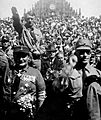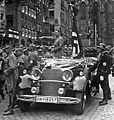Night of the Long Knives facts for kids
The Night of the Long Knives (German: Nacht der langen Messer), also called "Operation Hummingbird" (German: Kolibri), was a time when the Nazi government in Nazi Germany killed many people for political reasons. This happened between June 30 and July 2, 1934. At least 90 people were killed. Most of them were members of a group called the "Storm Troopers" (SA).
Adolf Hitler decided to act against the SA and its leader, Ernst Röhm. He saw the SA as too independent and its members often used violence in the streets. Hitler felt this was a direct threat to his own power. He also wanted to stop the leaders of the Reichswehr, which was the German army. The army leaders were afraid of the SA and didn't like them. Röhm had even said he wanted to take over the army and lead it himself. Finally, Hitler used this event to get rid of people who criticized his government. This included those who supported Vice-Chancellor Franz von Papen, and old enemies like Kurt von Schleicher.
Contents
What Was the Night of the Long Knives?
The Night of the Long Knives was a secret operation carried out by Adolf Hitler and the Nazi Party. It was a way for Hitler to get rid of people he saw as threats to his power. Many of those killed were leaders and members of the SA, a large Nazi paramilitary group. The event showed how ruthless Hitler was in making sure he had complete control.
Why Did Hitler Act?
Hitler had several reasons for ordering the killings during the Night of the Long Knives. He wanted to make sure no one could challenge his authority.
The SA and Ernst Röhm
The SA, or Storm Troopers, were important in helping Hitler rise to power. They were known for their street fights and intimidating opponents. However, by 1934, the SA had grown very large and powerful. Its leader, Ernst Röhm, was a close friend of Hitler. But Röhm wanted the SA to become the main army of Germany. This worried Hitler because it meant Röhm and the SA might become too powerful.
Concerns from the German Army
The regular German army, known as the Reichswehr, did not like the SA. They saw the SA as undisciplined and a threat to their own role. The army leaders were also worried about Röhm's ambition to take over the military. Hitler needed the army's support to stay in power. By getting rid of Röhm and weakening the SA, Hitler gained the trust of the army.
Removing Political Opponents
Hitler also used the Night of the Long Knives to silence other people who disagreed with him. This included conservative politicians like Franz von Papen, who was Hitler's Vice-Chancellor. Papen had recently given a speech criticizing the Nazi government. Old enemies, such as Kurt von Schleicher, who was Hitler's predecessor as Chancellor, were also killed. This helped Hitler remove anyone who might stand in his way.
Aftermath and Impact
After the Night of the Long Knives, Hitler's power became even stronger. The SA was greatly weakened, and the SS (another Nazi group) became more powerful. The German army swore an oath of loyalty directly to Hitler. This event showed that Hitler would use extreme violence to keep his control. It marked a key moment in the rise of his dictatorship.
Images for kids
-
SA leader Ernst Röhm in Bavaria in 1934
-
Hitler poses in Nuremberg with SA members in 1928. To his left is Julius Streicher, and standing beneath him is Hermann Göring.
-
Franz von Papen, the conservative vice-chancellor who ran afoul of Hitler after denouncing the regime's failure to rein in the SA in his Marburg speech. The photo was taken in 1946 at the Nuremberg trial.
-
SS-Brigadeführer Reinhard Heydrich, head of the Bavarian police and SD, in Munich, 1934
-
General Kurt von Schleicher, Hitler's predecessor as Chancellor, in uniform, 1932
-
Gregor Strasser in 1928
-
Election poster for Hindenburg in 1932 (translation: "With him")
-
Werner von Blomberg in 1934
See also
 In Spanish: Noche de los cuchillos largos para niños
In Spanish: Noche de los cuchillos largos para niños














